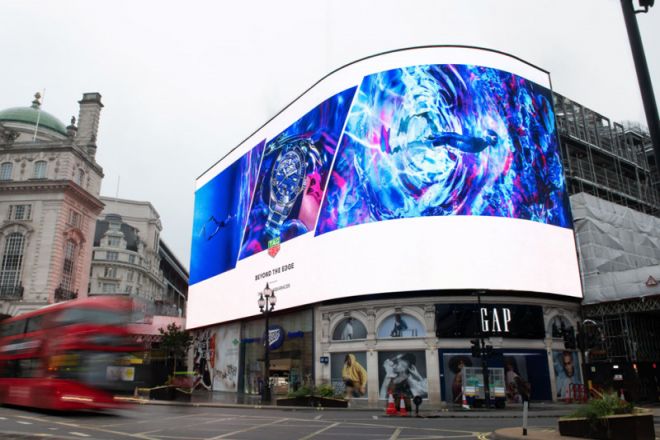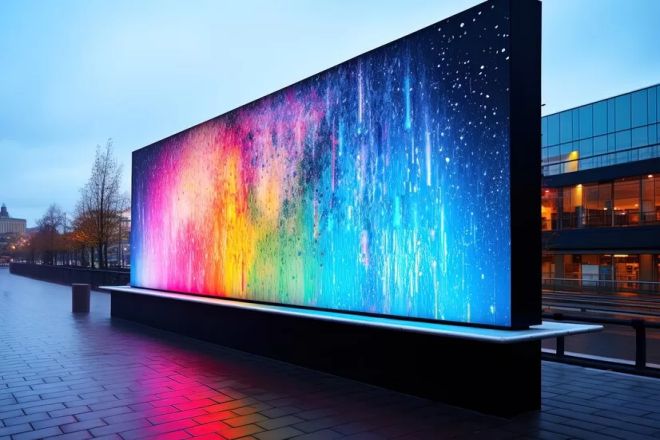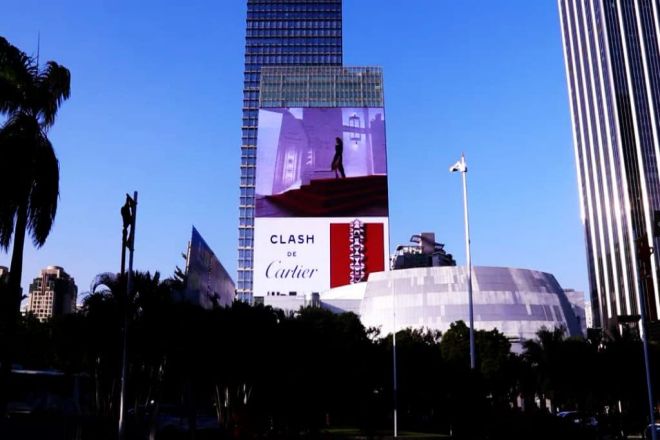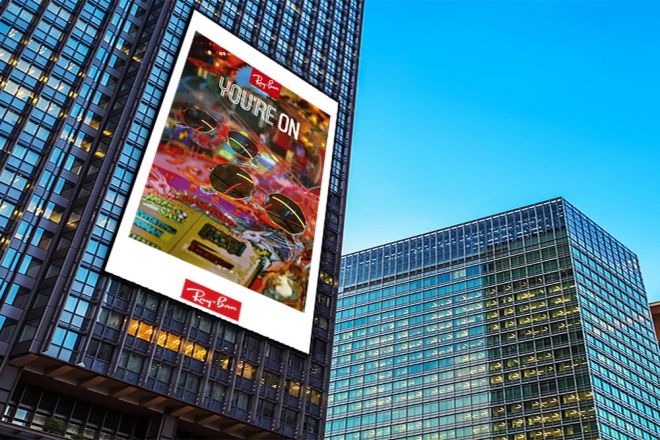Introducción

Con el rápido desarrollo de la ciencia y la tecnología y la aceleración de la urbanización, pantallas publicitarias led, as an emerging outdoor advertising medium, have gradually emerged in the advertising industry due to their high brightness, high definition, and bright colors. However, despite the many advantages of LED advertising screens, they have encountered a series of obstacles in their promotion and implementation.
1. High technical costs
1). Initial investment cost of LED advertising screens
1.1). Hardware costs:
Display screens: The price of LED display screens is mainly provided by manufacturers, and the price varies greatly depending on parameters such as size, resolution, and brightness. Generally speaking, the price of LED display screens per square meter may range from thousands of yuan to tens of thousands of yuan.
Control system: The control system is sold together with the screen, and the specific price depends on the size and complexity of the display. Generally speaking, the cost of the control system may account for 10% to 20% of the overall investment.
Power supply: The price of the power supply is usually based on the power demand of the display, and the price varies depending on the brand, quality, and power.
1.2). Installation cost:
Site rental: Depending on the geographical location of the city and the scarcity of advertising space, the site rental fee may be very high. In first-tier cities, the site rental fee may account for 20% to 30% of the overall investment.
Construction costs: Construction costs include installation, wiring, debugging, etc., and the costs vary depending on the scale and complexity of the project. Generally speaking, construction costs may account for 10% to 20% of the overall investment.
2). Operational costs and maintenance costs
- Consumo de energía:
The energy consumption of LED advertising screens mainly depends on their brightness, size, and playback time. Generally speaking, the daily electricity bill for a medium-sized LED advertising screen may be between tens of yuan and hundreds of yuan.
According to the information in the reference article, the power consumption of one square meter of outdoor high-brightness LED display is about 800 watts per hour, so the energy consumption cost needs to be estimated based on actual usage.
- Repair and replacement of parts:
The maintenance cost of LED advertising screens mainly includes factors such as the technical level of maintenance personnel, parts that need to be repaired, and the length of maintenance time.
According to market research, the cost of repairing large-screen advertising displays is generally between 2,000 yuan and 3,000 yuan, but the specific cost will vary depending on the actual situation. If more expensive parts need to be replaced, the cost will be higher.
- Equipment of professional technicians:
In order to ensure the normal operation and timely maintenance of LED advertising screens, professional technicians are required. The salary and welfare expenses of these personnel are also part of the operating costs.
2. Restrictions on regulations and policies

1). Urban planning and building approval
- Restrictions on the location, height, size, etc. of billboards:
According to the “Nanning Outdoor Advertising and Signage Planning Guidelines” and other documents, the setting of billboards needs to follow a series of regulations.
For example, outdoor electronic display screens are only allowed to be set up in multi-story buildings and podiums of high-rise buildings with a building height not exceeding 24 meters, and the distance from the upper edge to the ground shall not be greater than half of the minimum distance of the building setback from the side of the road.
These regulations restrict the location and size of billboards, which limits the promotion of LED advertising screens to a certain extent.
- The approval process is cumbersome and time-consuming:
The setting of billboards needs to be approved by multiple departments, including urban management, planning, and environmental protection. The cumbersome and time-consuming approval process has brought inconvenience to the implementation of LED advertising screens.
2). Environmental protection regulations
- Light source pollution restrictions:
The excessive brightness of LED advertising screens may cause light source pollution and affect the normal life of residents. Therefore, environmental protection regulations restrict the brightness and flickering frequency of LED advertising screens to reduce the impact of light source pollution.
- Energy consumption and emission standards:
The energy consumption and emissions of LED advertising screens are also the focus of environmental protection regulations.
According to the “Outdoor Electronic Display Screen Management Specifications-Environmental Protection System” and other documents, the night brightness value of LED advertising screens should be ≤1000dm² (commercial areas) or ≤400dm² (other areas), and it is necessary to have the function of adjusting the display brightness according to the changes in sunlight intensity.
In addition, the energy consumption and emission standards of LED advertising screens must also comply with the requirements of relevant regulations.
3). Advertising regulations
- Advertising content review:
Advertising content must comply with national laws and regulations and advertising review standards. According to the “Advertising Law of the People’s Republic of China” and other relevant regulations, advertising content must not contain illegal, false, vulgar and other content, and must be reviewed by relevant departments before it can be released.
- Advertising broadcast time and frequency:
Advertising regulations also restrict the broadcast time and frequency of LED advertising screens.
For example, if outdoor electronic display screens are set up on both sides of the main roads in the city (except for closed squares and pedestrian streets in the city), the screen switching should adopt a slow conversion method. In principle, the playback time of each fixed screen should be ≥15 seconds. In addition, LED advertising screens must play public welfare content for no less than 20% of the time during the playback process.
These regulations limit the playback time and frequency of LED advertising screens, which has a certain impact on their commercial benefits.
3. Restrictions on regulations and policies
1). Urban planning and building approval
- Restrictions on the location, height, size, etc. of billboards:
According to the “Nanning Outdoor Advertising and Signage Planning Guidelines” and other documents, the setting of billboards needs to follow a series of regulations.
For example, outdoor electronic display screens are only allowed to be set up in multi-story buildings and high-rise building podiums with a building height not exceeding 24 meters, and the distance from the upper edge to the ground shall not be greater than half of the minimum distance of the building setback from the side of the road.
These regulations restrict the location and size of billboards, which limits the promotion of LED advertising screens to a certain extent.
- The approval process is cumbersome and time-consuming:
The setting of billboards needs to be approved by multiple departments, including urban management, planning, and environmental protection. The cumbersome and time-consuming approval process has brought inconvenience to the implementation of LED advertising screens.
2). Environmental protection regulations
Light source pollution restrictions:
The excessive brightness of LED advertising screens may cause light source pollution and affect the normal life of residents. Therefore, environmental protection regulations have set limits on the brightness and flickering frequency of LED advertising screens to reduce the impact of light source pollution.
Energy consumption and emission standards:
The energy consumption and emissions of LED advertising screens are also the focus of environmental protection regulations.
According to the “Outdoor Electronic Display Screen Management Specifications-Environmental Protection System” and other documents, the night brightness value of the LED advertising screen should be ≤1000dm² (commercial area) or ≤400dm² (other areas), and it is necessary to have the function of adjusting the display brightness according to the change of sunlight intensity.
In addition, the energy consumption and emission standards of the LED advertising screen must also comply with the requirements of relevant regulations.
3). Advertising regulations
- Advertising content review:
Advertising content must comply with national laws and regulations and advertising review standards. According to the “Advertising Law of the People’s Republic of China” and other relevant regulations, advertising content must not contain illegal, false, vulgar and other content, and must be reviewed by relevant departments before it can be released.
- Advertising broadcast time and frequency:
Advertising regulations also restrict the broadcast time and frequency of LED advertising screens. For example, if outdoor electronic display screens are set up on both sides of the main roads in the city (except for closed squares and pedestrian streets in the city), the screen switching should adopt a slow conversion method.
In principle, the playback time of each fixed screen should be ≥15 seconds. In addition, the LED advertising screen must play public welfare content for no less than 20% of the time during the playback process. These regulations limit the playback time and frequency of LED advertising screens, which has a certain impact on their commercial benefits.
4). Social and cultural factors
4.1). Residents’ acceptance
Concerns about visual pollution: Residents are concerned that the high brightness and frequent flashing of LED advertising screens may cause visual discomfort and even health problems, so they are reserved about such advertising screens.
Impact on the urban landscape: The establishment of LED advertising screens may affect the overall landscape and style of the city, and is inconsistent with the traditional architecture and cultural atmosphere of the city, causing dissatisfaction and protests from residents.
5). Community relations
Conflict of interest between residents and advertisers: Residents and advertisers may have conflicts of interest due to the establishment and operation of LED advertising screens. Residents may worry about the impact of noise, light, etc., from advertising screens on their lives while advertisers pursue maximum commercial benefits.
Residents’ protests and oppositions: If the establishment of LED advertising screens fails to gain the recognition and support of residents, it may trigger protests and opposition from residents. These protests and oppositions may appear in various forms, including demonstrations, complaints, and legal proceedings.
6). Traditional culture and values
Acceptance of advertising culture: Different social and cultural backgrounds have different acceptance of advertising culture. In some cultures, advertising is seen as an extension of commercial behavior, while in other cultures, advertising may be seen as an infringement on public space.
Dislike for advertisements invading personal space: As people pay more attention to the privacy of personal space, some people may feel uncomfortable and disgusted with the widespread establishment and broadcast of LED advertising screens. They think these advertising screens may infringe on their personal space and privacy.
4. Technical Challenges and Limitations

1). Display Effect and Technical Stability
1.1). Technical Indicators:
- Resolución:
The resolution of the LED display directly determines the clarity and accuracy of the displayed image. The higher the resolution, the more pixels there are, and the clearer the displayed image. According to reference article 2, the unit of resolution is a pixel.
In general commercial advertising display screens or information display screens, the resolution of 720p can already meet the needs, while in some specific scenarios, such as large projection screens, 1080p or 4K resolution may be required.
- Brillo:
The brightness requirement is determined by the specific application scenario. The brightness requirement for indoor display screens is 500-1500cd/m2, while the brightness requirement for outdoor display screens is generally 5000-8000cd/m2 to ensure that sufficient brightness can be generated in outdoor environments to offset the interference of sunlight.
- Reproducción de colores:
A high-quality LED display screen should be able to accurately restore colors to ensure the true presentation of advertisements or information.
2). Stability and reliability under long-term operation:
Long-term operation may cause problems such as temperature increase, brightness decrease, and color distortion on the LED display screen. In order to ensure the stability and reliability of LED display screens, it is necessary to take reasonable heat dissipation design, strict process and production management, strengthen product testing and quality control and other measures (reference article 1).
The weather resistance and stability of full-color LED display screens are particularly important in the application of outdoor billboards. They use special materials such as waterproof, dustproof, shockproof, and corrosion-resistant, as well as advanced control technology and stable driving mode to ensure long-term stable operation under harsh climatic conditions (reference article 3).
3). Data transmission and update
The speed and efficiency of real-time data update: In LED display screen projects, the real-time update speed and efficiency of data are crucial to the transmission of information. In order to achieve fast data updates, efficient data processing technology and data transmission technology need to be adopted.
4). Remote management and control of advertising content:
- Monitoreo remoto:
Connect to the LED display screen through the network to monitor and grasp the various states of the display screen in real-time, including brightness, grayscale, operating temperature, display content, etc. (reference article 6).
- Remote debugging:
When the display screen fails or abnormal conditions occur, remote debugging can be performed through the remote management system to improve the efficiency of fault handling (reference article 6).
- Remote parameter setting:
The remote management system can also remotely set the parameters of the LED display, including brightness, contrast, color temperature, etc., to meet the display effects under different environments and requirements (reference article 6).
- Actualización de contenido:
Through the remote management system, users can easily and quickly update the advertising content, including pictures, videos, and texts (reference article 6). This remote management and control method not only improves the efficiency of updating advertising content but also reduces operation and maintenance costs.
5. Market competition and profit model
1). Fierce market competition
Fierce competition for advertising space:
With the widespread application of LED display screens in the field of advertising media, the competition for advertising space has become increasingly fierce. Major business districts, transportation hubs, public places, etc., have become the focus of advertisers.
According to reference articles 1 and 2, LED display screens are widely used in advertising, media, stage, commercial display, and other fields due to their high brightness, long service life, rich and colorful colors, and wide viewing angle, which further intensifies the competition for advertising space.
- Uncertainty of advertising price and delivery effect:
Advertising price is affected by many factors, such as advertising position, size, audience group, etc., and it is difficult to determine a unified price standard.
At the same time, the effect of advertising is also affected by many factors, such as advertising content, audience acceptance, etc., which are difficult to predict and guarantee. This uncertainty brings great risks and challenges to advertisers.
2). Single profit model
- Mainly dependent on advertising revenue:
At present, the profit model of the LED display industry mainly relies on advertising revenue. However, with the intensification of market competition and the fluctuation of advertising prices, a single profit model faces greater risks.
According to reference article 4, although LED display screens, as indispensable display equipment for events such as concerts, have been used in the rental market to a certain extent, the industry as a whole is still highly dependent on advertising revenue.
- Lack of diversified profit models:
In addition to advertising revenue, the LED display industry lacks other effective profit models. Although some companies try to increase their sources of income by providing value-added services and technical support, these models have not yet formed a scale and have limited contributions to the industry.
In order to cope with fierce market competition and profit pressure, the LED display industry needs to actively explore diversified profit models, such as expanding new application areas, developing new products and services, etc.
6. Solutions and Future Outlook

1). Reducing Technology Costs
- Technological innovation reduces production costs:
Reference article 3 mentions that by increasing the processing wafer size of LED display devices (such as from 2 inches to 4 inches), the processing cost of chip technology can be greatly reduced.
In addition, the advancement of LED electronic display core equipment manufacturing technology, especially the productivity improvement of MOCVD (organic metal chemical vapor deposition) equipment, will also significantly reduce the depreciation cost of LED displays.
- Improve energy efficiency and reduce operating costs:
By adopting more efficient LED light sources and optimizing circuit design and heat dissipation systems, the energy efficiency of LED display screens can be improved, and daily operating costs can be reduced.
- Strengthen regulations and policy guidance.
Improve advertising regulations and urban planning: Reference article 7 mentions that in response to the noise, light pollution, and other problems caused by outdoor LED advertising screens, local governments have issued relevant management methods and standards, such as the “Beijing Outdoor Electronic Display Screen Setting Specifications.”
In the future, relevant regulations should be further improved to ensure the reasonable layout and orderly development of LED display screens.
- Provide policy support and incentives:
The government can encourage enterprises to increase R&D investment and promote the innovation and application of LED display technology through financial subsidies and tax incentives. At the same time, the development of the LED display industry can also be supported by setting up special funds and guiding social capital participation.
2). Enhance social acceptance
Strengthen public publicity and education:
Through media, community activities, and other means, strengthen the public’s understanding and awareness of LED display technology, and eliminate their concerns and misunderstandings about light pollution, noise, and other issues.
At the same time, enterprises and institutions can also be encouraged to use LED display screens in public welfare activities to demonstrate their social value and positive image.
- Optimize advertising content and form:
By improving the creativity and artistry of advertising content and adopting more environmentally friendly and energy-saving advertising forms (such as dynamic pictures, interactive advertising, etc.), the attractiveness and social acceptance of LED display screens can be enhanced.
3). Explore new profit models.
- Develop diversified services:
In addition to traditional advertising revenue, LED display screen companies can actively explore diversified service models, such as providing data visualization services, intelligent monitoring services, rental services, etc., to meet the needs of different customers.
- Expand online and offline linkage business models:
Combining the Internet and big data technology, LED display screen companies can develop online platforms or applications to achieve online and offline linkage marketing.
For example, by publishing advertising information and collecting user feedback through online platforms, the advertising effect and user experience can be improved; at the same time, offline LED screens can also be used to display online advertising content or event information to achieve online and offline interaction and integration.
This business model helps to expand the company’s revenue sources and improve market competitiveness.
Conclusión
In summary, the promotion and implementation of LED advertising screens face many obstacles, including technical costs, regulations and policies, social culture, technical challenges, market competition, and profit models. However, it is these challenges and difficulties that also provide us with opportunities for innovation and improvement.
By reducing technical costs, strengthening regulatory guidance, enhancing social acceptance, and exploring new profit models, we are expected to overcome these obstacles and promote the healthy development of LED advertising screens.
Por último, si quieres saber más sobre las pantallas LED, Por favor póngase en contacto con nosotros.
